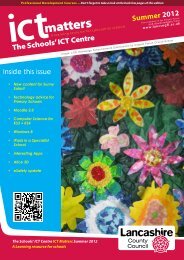Cover - Narrative Writing.pub
Cover - Narrative Writing.pub
Cover - Narrative Writing.pub
You also want an ePaper? Increase the reach of your titles
YUMPU automatically turns print PDFs into web optimized ePapers that Google loves.
Year Objectives relating to CHARACTER<br />
Reception T5 to understand how story book language works and to use some formal elements when retelling<br />
stories. e.g. ‘Once there was . . .’ ‘She lived in a little’,<br />
Year 1 Term 2 T8 to identify and discuss characters, e.g. appearance, behaviour, qualities; to speculate about<br />
how they might behave; to discuss how they are described in the text; and to compare characters<br />
from different stories or plays;<br />
T9 to become aware of characters and dialogue, e.g. by role playing parts when reading aloud<br />
stories or plays.<br />
T15 to build simple profiles of characters from stories read, describing characteristics,<br />
appearances, behaviour with pictures, single words, captions, words and sentences from text.<br />
Y2 Term 2 T6 to identify and describe characters, expressing views and using words and phrases from texts.<br />
T14 to write character profiles, e.g. simple descriptions, posters, passports, using key words and<br />
Y3 Term 2<br />
Y3 Term 3<br />
Y4 Term 1<br />
Y4 Term 3<br />
Y5 Term 1<br />
Y5 Term 3<br />
Y6 Term 1<br />
phrases that describe or are spoken by characters in the text.<br />
T3 to identify and discuss main and recurring characters, evaluate their behaviour and justify<br />
views.<br />
T8 to write portraits of characters, using story text to describe behaviour and characteristics, and<br />
presenting portraits in a variety of ways, e.g. as posters, labelled diagrams, letters to friends about<br />
them.<br />
T5 to discuss (I) characters’ feelings; (ii) behaviour, e.g. fair or unreasonable, brave or foolish; (iii)<br />
relationships, referring to the text and making judgements.<br />
T1 to investigate how characters are built up from small details, and how the reader responds to<br />
them.<br />
T2 to identify the main characteristics of the key characters, drawing on the text to justify views,<br />
and using the information to predict actions.<br />
T11 to write character sketches, focusing on small details to evoke sympathy or dislike.<br />
T11 to explore the main issues of a story by writing a story about a dilemma and the issues it<br />
raises for the character.<br />
T3 to investigate how characters are presented, referring to the text:<br />
� through dialogue, action and description;<br />
� how the reader responds to them (as victims, heroes, etc.);<br />
� through examining their relationships with other characters.<br />
T15 to write new characters into a story, in the manner of the writer, maintaining consistency of<br />
character and style, using paragraphs to organise and develop detail.<br />
T2 to identify the point of view from which the story is told and how this affects the reader’s<br />
response.<br />
T3 to change point of view, e.g. tell incident or describe from the point of view of another character<br />
or perspective.<br />
T7 to write from another character’s point of view, e.g. retelling an incident in letter form.<br />
T7 to plan quickly and effectively the plot, characters and structure of their own narrative writing.



